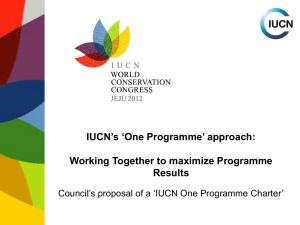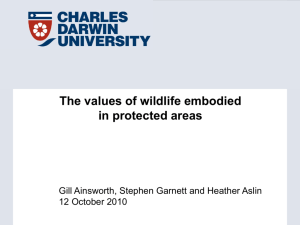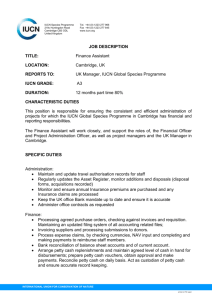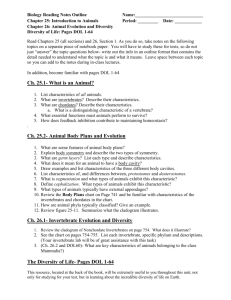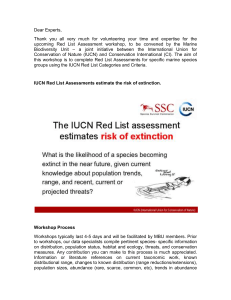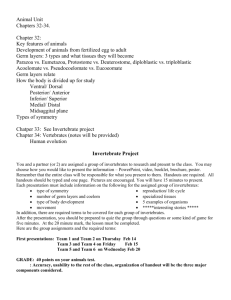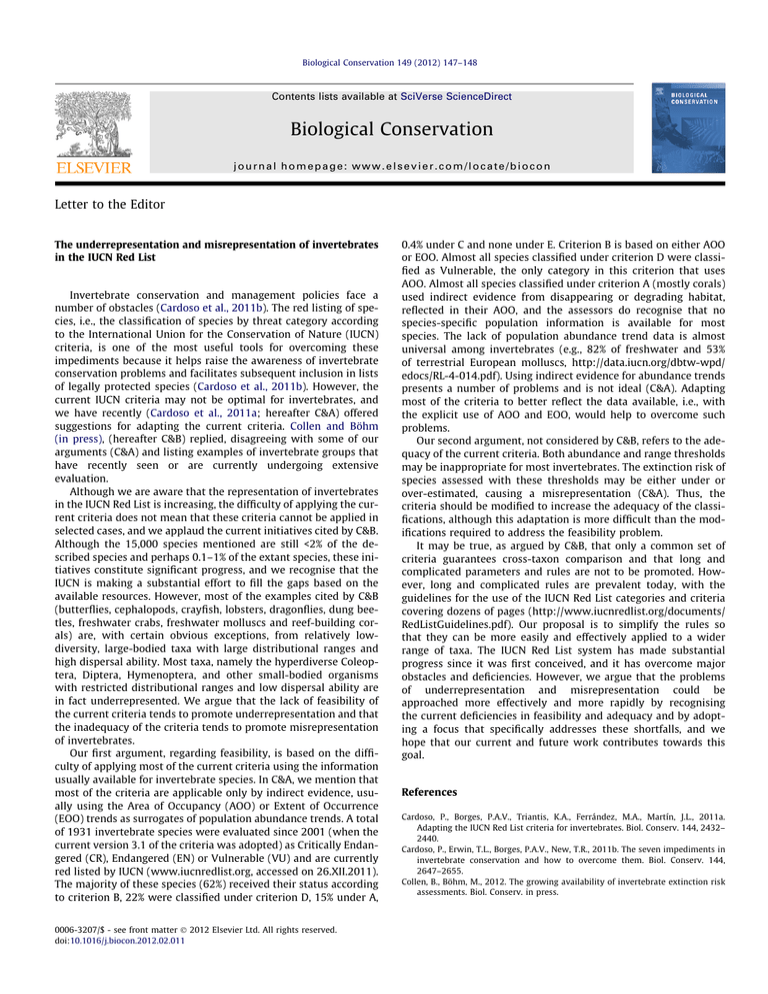
Biological Conservation 149 (2012) 147–148
Contents lists available at SciVerse ScienceDirect
Biological Conservation
journal homepage: www.elsevier.com/locate/biocon
Letter to the Editor
The underrepresentation and misrepresentation of invertebrates
in the IUCN Red List
Invertebrate conservation and management policies face a
number of obstacles (Cardoso et al., 2011b). The red listing of species, i.e., the classification of species by threat category according
to the International Union for the Conservation of Nature (IUCN)
criteria, is one of the most useful tools for overcoming these
impediments because it helps raise the awareness of invertebrate
conservation problems and facilitates subsequent inclusion in lists
of legally protected species (Cardoso et al., 2011b). However, the
current IUCN criteria may not be optimal for invertebrates, and
we have recently (Cardoso et al., 2011a; hereafter C&A) offered
suggestions for adapting the current criteria. Collen and Böhm
(in press), (hereafter C&B) replied, disagreeing with some of our
arguments (C&A) and listing examples of invertebrate groups that
have recently seen or are currently undergoing extensive
evaluation.
Although we are aware that the representation of invertebrates
in the IUCN Red List is increasing, the difficulty of applying the current criteria does not mean that these criteria cannot be applied in
selected cases, and we applaud the current initiatives cited by C&B.
Although the 15,000 species mentioned are still <2% of the described species and perhaps 0.1–1% of the extant species, these initiatives constitute significant progress, and we recognise that the
IUCN is making a substantial effort to fill the gaps based on the
available resources. However, most of the examples cited by C&B
(butterflies, cephalopods, crayfish, lobsters, dragonflies, dung beetles, freshwater crabs, freshwater molluscs and reef-building corals) are, with certain obvious exceptions, from relatively lowdiversity, large-bodied taxa with large distributional ranges and
high dispersal ability. Most taxa, namely the hyperdiverse Coleoptera, Diptera, Hymenoptera, and other small-bodied organisms
with restricted distributional ranges and low dispersal ability are
in fact underrepresented. We argue that the lack of feasibility of
the current criteria tends to promote underrepresentation and that
the inadequacy of the criteria tends to promote misrepresentation
of invertebrates.
Our first argument, regarding feasibility, is based on the difficulty of applying most of the current criteria using the information
usually available for invertebrate species. In C&A, we mention that
most of the criteria are applicable only by indirect evidence, usually using the Area of Occupancy (AOO) or Extent of Occurrence
(EOO) trends as surrogates of population abundance trends. A total
of 1931 invertebrate species were evaluated since 2001 (when the
current version 3.1 of the criteria was adopted) as Critically Endangered (CR), Endangered (EN) or Vulnerable (VU) and are currently
red listed by IUCN (www.iucnredlist.org, accessed on 26.XII.2011).
The majority of these species (62%) received their status according
to criterion B, 22% were classified under criterion D, 15% under A,
0006-3207/$ - see front matter Ó 2012 Elsevier Ltd. All rights reserved.
doi:10.1016/j.biocon.2012.02.011
0.4% under C and none under E. Criterion B is based on either AOO
or EOO. Almost all species classified under criterion D were classified as Vulnerable, the only category in this criterion that uses
AOO. Almost all species classified under criterion A (mostly corals)
used indirect evidence from disappearing or degrading habitat,
reflected in their AOO, and the assessors do recognise that no
species-specific population information is available for most
species. The lack of population abundance trend data is almost
universal among invertebrates (e.g., 82% of freshwater and 53%
of terrestrial European molluscs, http://data.iucn.org/dbtw-wpd/
edocs/RL-4-014.pdf). Using indirect evidence for abundance trends
presents a number of problems and is not ideal (C&A). Adapting
most of the criteria to better reflect the data available, i.e., with
the explicit use of AOO and EOO, would help to overcome such
problems.
Our second argument, not considered by C&B, refers to the adequacy of the current criteria. Both abundance and range thresholds
may be inappropriate for most invertebrates. The extinction risk of
species assessed with these thresholds may be either under or
over-estimated, causing a misrepresentation (C&A). Thus, the
criteria should be modified to increase the adequacy of the classifications, although this adaptation is more difficult than the modifications required to address the feasibility problem.
It may be true, as argued by C&B, that only a common set of
criteria guarantees cross-taxon comparison and that long and
complicated parameters and rules are not to be promoted. However, long and complicated rules are prevalent today, with the
guidelines for the use of the IUCN Red List categories and criteria
covering dozens of pages (http://www.iucnredlist.org/documents/
RedListGuidelines.pdf). Our proposal is to simplify the rules so
that they can be more easily and effectively applied to a wider
range of taxa. The IUCN Red List system has made substantial
progress since it was first conceived, and it has overcome major
obstacles and deficiencies. However, we argue that the problems
of underrepresentation and misrepresentation could be
approached more effectively and more rapidly by recognising
the current deficiencies in feasibility and adequacy and by adopting a focus that specifically addresses these shortfalls, and we
hope that our current and future work contributes towards this
goal.
References
Cardoso, P., Borges, P.A.V., Triantis, K.A., Ferrández, M.A., Martín, J.L., 2011a.
Adapting the IUCN Red List criteria for invertebrates. Biol. Conserv. 144, 2432–
2440.
Cardoso, P., Erwin, T.L., Borges, P.A.V., New, T.R., 2011b. The seven impediments in
invertebrate conservation and how to overcome them. Biol. Conserv. 144,
2647–2655.
Collen, B., Böhm, M., 2012. The growing availability of invertebrate extinction risk
assessments. Biol. Conserv. in press.
148
Letter to the Editor / Biological Conservation 149 (2012) 147–148
⇑
Pedro Cardoso a,b,
Paulo A.V. Borges b
Kostas A. Triantis b,c
Miguel A. Ferrández d
José L. Martín e
a
Smithsonian Institution, National Museum of Natural History,
Washington, DC, USA
b
Azorean Biodiversity Group (CITA-A), University of the Azores,
Angra do Heroísmo, Portugal
c
Department of Ecology and Taxonomy, Faculty of Biology,
National and Kapodistrian University of Athens,
Athens, Greece
d
Society for the Study and Conservation of Spiders,
Madrid, Spain
e
The Canary Agency for Sustainable Development and Climate Change,
Santa Cruz de Tenerife, Canary Islands, Spain
⇑ Corresponding author. Address: Azorean Biodiversity Group
(CITA-A), Universidade dos Açores, Rua Capitão João d’Ávila,
9700-042 Angra do Heroísmo, Portugal
Tel.: +351 295 402 200; fax: +351 295 402 205.
E-mail address: pcardoso@ennor.org (P. Cardoso)
Available online 24 March 2012



